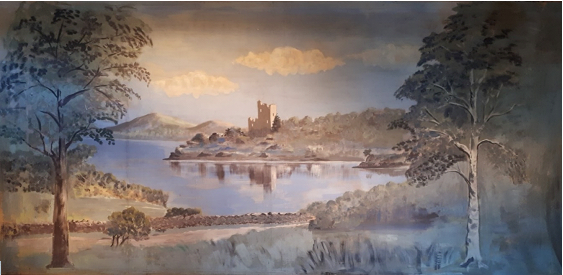Christchurch Folk Music Club
Irish Society Backdrop

The Irish Society Hall’s Backdrop
Showing an artistic talent few expected, commercial painter Nicky McMullan created this widely admired painted scene on canvas in late 1961 from his imagination. The castle does not exist but the skilful composition evokes mystique. It consists of four canvas panels stitched together and measures 6.5 metres wide by 3.2 metres in height. Notes from the author’s interview with Nicky’s daughter Maureen Bonham, dated 31.12.2021, state that Nicky ‘developed artistic painting skills from his uncle, but was never formally trained.’ The notes further state that smaller, framed paintings were donated to Nazareth House. The backdrop was a feature at 363 St Asaph Street until the Hall’s sale in 1987, then hung at 29 Domain Terrace for the visit of the Irish President Mrs Robinson before being rolled up and stored in the upstairs committee room. From 2019 it has graced the hall again. It is beautifully illuminated now by four white flood lights and serves as a worthy backdrop for the stage.
Extract from ‘Archives Build History’
Author: Tony Hale
Published for the Christchurch Irish Society 75th Anniversary 2023
Photo by the author
In Search of Native Song, Traditional Folksong Collecting in New Zealand
In Search of Native Song Traditional Folksong Collecting in New Zealand Article by Phil Garland. Click here to read.
Gone but not Forgotten A Slideshow by Chris Priestley
A slideshow for the Unsung Heroes concert at the Auckland Folk Festival remembering folk legends and friends who are no longer with us. You are sure to recognise at least one person on this video compilation
Kim Bonnington Tour Poster
To view click here
The String Contingent – Tour Poster
View poster here
Paul Marks
Read more below: ARCA Desk Tape Series - Paul Marks - Support Act - Support Act The Historic Record Recording ‘Paul Marks Live At Christchurch Folk Club' Released In ARCA Series - Noise11.com Paul Marks - LIVE at the Christchurch Folk Club 1968 (ffm.to)